Bulletin E3471
Hosta Pests and Diseases
August 3, 2022 - Amanda Howland and Marisol Quintanilla, Department of Entomology, Michigan State University

This publication contains pesticide recommendations based on research and pesticide regulations. However, changes in pesticide regulations occur constantly. Some pesticides mentioned may no longer be available, and some uses may no longer be legal. If you have questions about the legality and/or registration status for using pesticides, contact your county Extension office.
The information contained herein does not supersede the label directions. To protect yourself, others, and the environment, always read the label before applying any pesticide.
Contents
- Hosta Quick Facts
- What’s Wrong With My Hostas?
- Pests
- Pathogens and Diseases
- Find Out More
- References
Hosta Quick Facts
- Hostas are cold-hardy perennials that thrive in hardiness zones 3 to 9, so they’re great for Michigan gardens!
- Breeders have developed over 2,500 hosta cultivars with a variety of leaf shapes, sizes, colors, patterns, and textures.
- Hostas are best known for their diverse foliage, which ranges from deep, waxy blue through many shades of green to bright yellow. The leaves of many varieties have cream or white edges or stripes.
- Hostas flower from early summer to early fall in shades of pink, lavender, light blue, or white.
- Most hostas are shade-loving or prefer partial, filtered sun.
- Hostas prefer well-drained, fertile soils.
- Hostas are propagated by dividing the crowns or by tissue culturing.
What’s Wrong With My Hostas?
Hostas (Hosta spp.) are relatively pest- and disease-free, which makes them great plants for home gardens. Like every plant, however, they do have some enemies:
- Pests (including some wildlife, slugs and snails, insects, and plant-parasitic nematodes)
- Pathogenic organisms (such as fungi and viruses) and the diseases they cause (such as anthracnose, hosta virus X, and southern blight)
This bulletin covers the major pests and diseases that affect hostas to help you identify what’s causing the signs and symptoms you’re seeing in your plants.
Pests
This section covers the wildlife, slugs and snails, insects, and plant-parasitic nematodes that are major threats to hostas. It also offers methods you can use to help prevent or control these pests.
Wildlife
Even being planted in the shelter of a suburban or urban neighborhood is no guarantee that hostas will be safe from hungry wildlife like deer, rabbits, slugs and snails, and voles and mice.
Deer
Deer are major pests of hostas because deer love to eat hostas, especially the flowers!
Control:
To discourage deer, you can:
- Surround your hostas with plants deer don’t like to eat.
- Build a 9- or 10-foot-high woven-wire fence around your yard to keep the deer out.
- Use deer repellents on or near the hostas. (Note: You’ll need to renew repellents periodically, and after every heavy rainfall.)
None of these controls are 100% effective, so if deer frequent your neighborhood you may have to learn to tolerate some deer damage.
Rabbits
Rabbits also enjoy eating the foliage of hosta plants, especially the young, tender leaves. You can tell rabbits are feeding on your hostas by the clean-cut chew marks on the leaves and stems.
Control:
- Apply rabbit repellents or sprays to help keep rabbits away from your hostas. You’ll need to reapply the repellents periodically and after heavy rainfalls.
- Place low, tightly woven fences or chicken wire around beds or individual plants to help keep rabbits out.
Slugs and Snails
Slugs and snails are major pests of hostas that can cause large, irregular, unsightly holes on the foliage (Figure 1). Slime trails are also a dead giveaway that these mollusks are eating your hostas. Since slugs and snails need a moist environment to survive, they usually hide during the day and feed at night.
Control:
- Use baited traps in the early spring and after rainfalls during the rest of the growing season.
- Thin the leaves of crowded hosta plants to increase air movement. This helps the dew and raindrops on the remaining leaves dry out faster and makes them less attractive to slugs and snails.
- Scatter a light layer of sand (especially coarse sand) around your plants because slugs and snails don’t like to cross dry, coarse textures.
- Mow regularly and remove debris near your hosta plants to remove hiding places and help keep these pests off your hostas.
- Plant slug-resistant hostas. Check with your local nursery about such varieties.
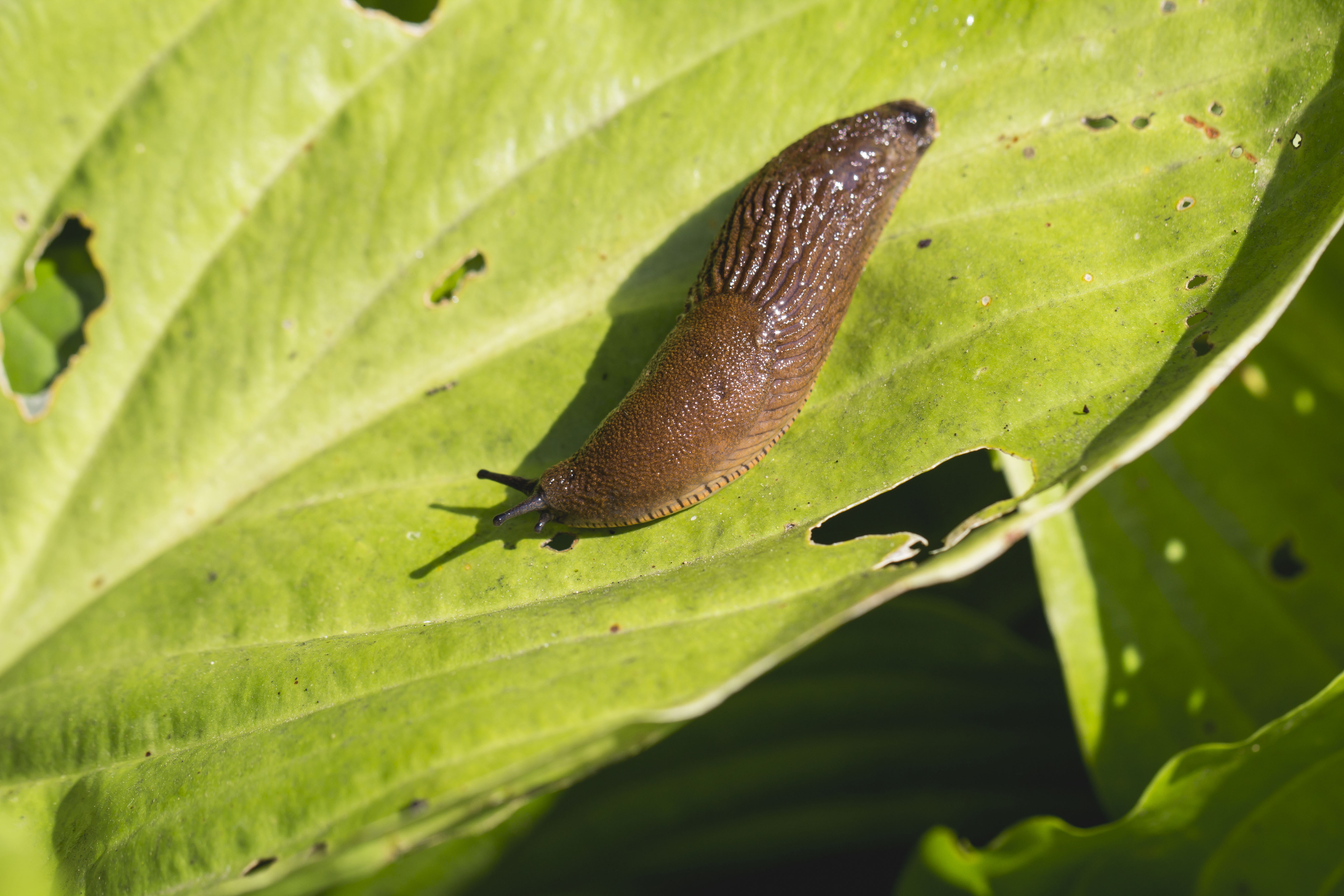
Voles and Mice
These creatures tunnel underground and can eat the roots of hosta plants. Wilted plants with reduced or no roots are often a sign that voles and mice have been dining on your hostas.
Control:
Sprinkle cayenne pepper or pepper flakes on the soil around your hostas to help deter voles and mice. You can also apply sprays or poison baits to the soil to repel or kill these pests.
Insects
The major insect pests of hostas include black vine weevils, blister and leaf beetles, and cutworms. Minor insect pests include aphids and grasshoppers.
Black Vine Weevils
Black vine weevils are also called just black bugs. The adults (Figure 2) chew on plant leaves at night, causing characteristic half-moon notched leaves. The larvae feed on hostas’ roots and lower stems, which can kill the plant.
Control:
- Apply an insecticide labeled for ornamental plants.
- Spray with an insecticidal soap.
- Remove mulch and other hiding places from around the base of plants.
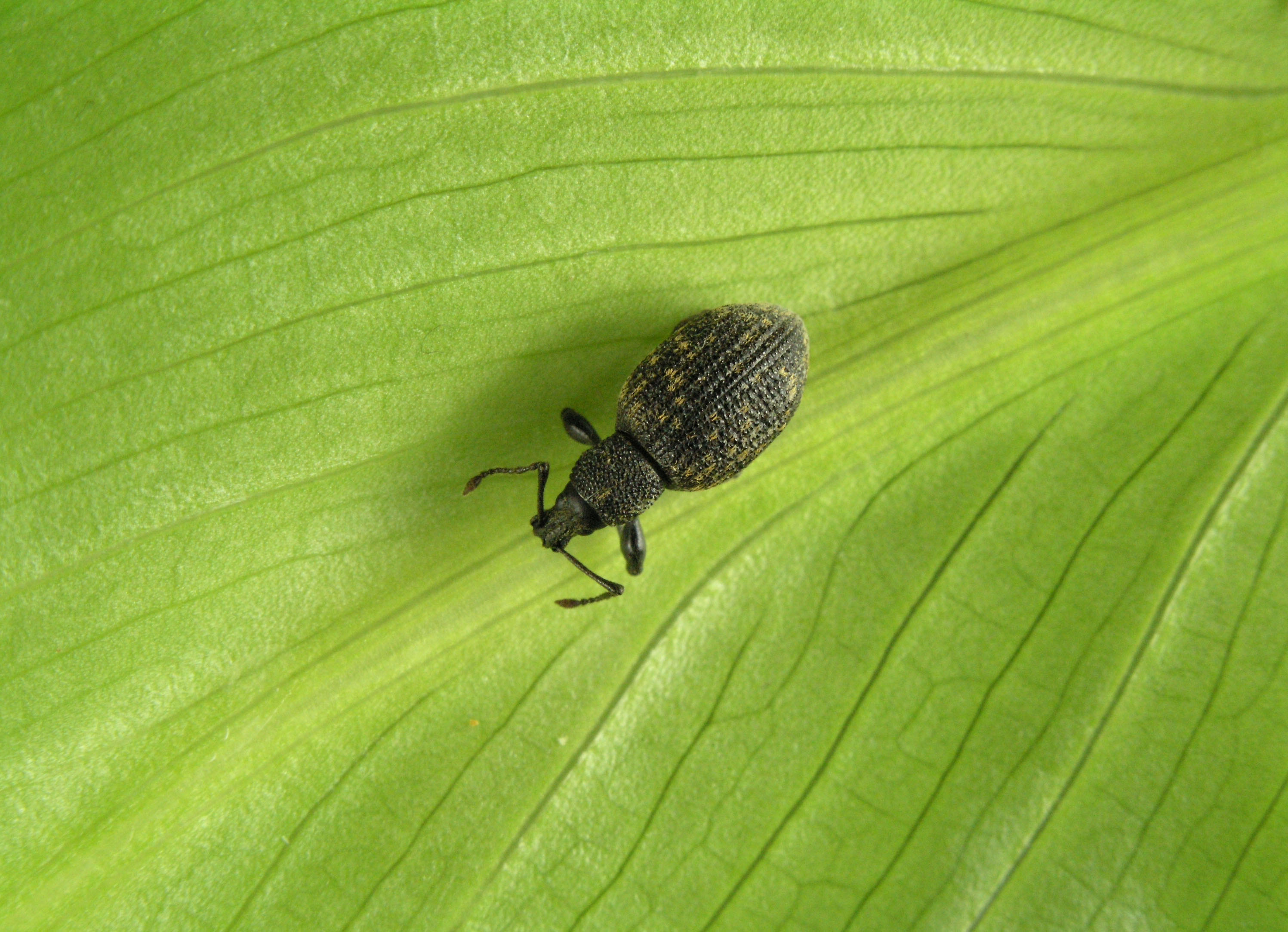
Blister Beetles and Leaf Beetles
Blister beetles and leaf beetles chew on hosta leaves causing ragged edges and defoliation. Many beetle species feed on ornamental plants in gardens, so watch for beetles of any species on your hostas.
Control:
- Apply an insecticide labeled for use in ornamental plants.
- Spray the plants with an insecticidal soap or neem oil.
Cutworms
Cutworms (Figure 3) are the larvae of several moth species that can severely damage or kill hosta seedlings in the early spring. They typically feed on the base of plants at the soil line.
Control:
- Pull dead foliage in the late fall or winter so the adult moths have nowhere to lay their eggs.
- Apply an insecticide labeled for ornamental plants.
- In the spring when the plants are still small, place a barrier such as a ring of cardboard vertically in the soil about 1 inch out from the crown of each plant to block cutworms from reaching the crown. Bury the cardboard ring a few inches deep in the soil, leaving about 1 inch above the soil surface. You won’t need to replace the cardboard ring after a rainfall unless it completely falls apart. Because cutworms are generally only a problem in the early spring, the ring will likely outlast their active period.
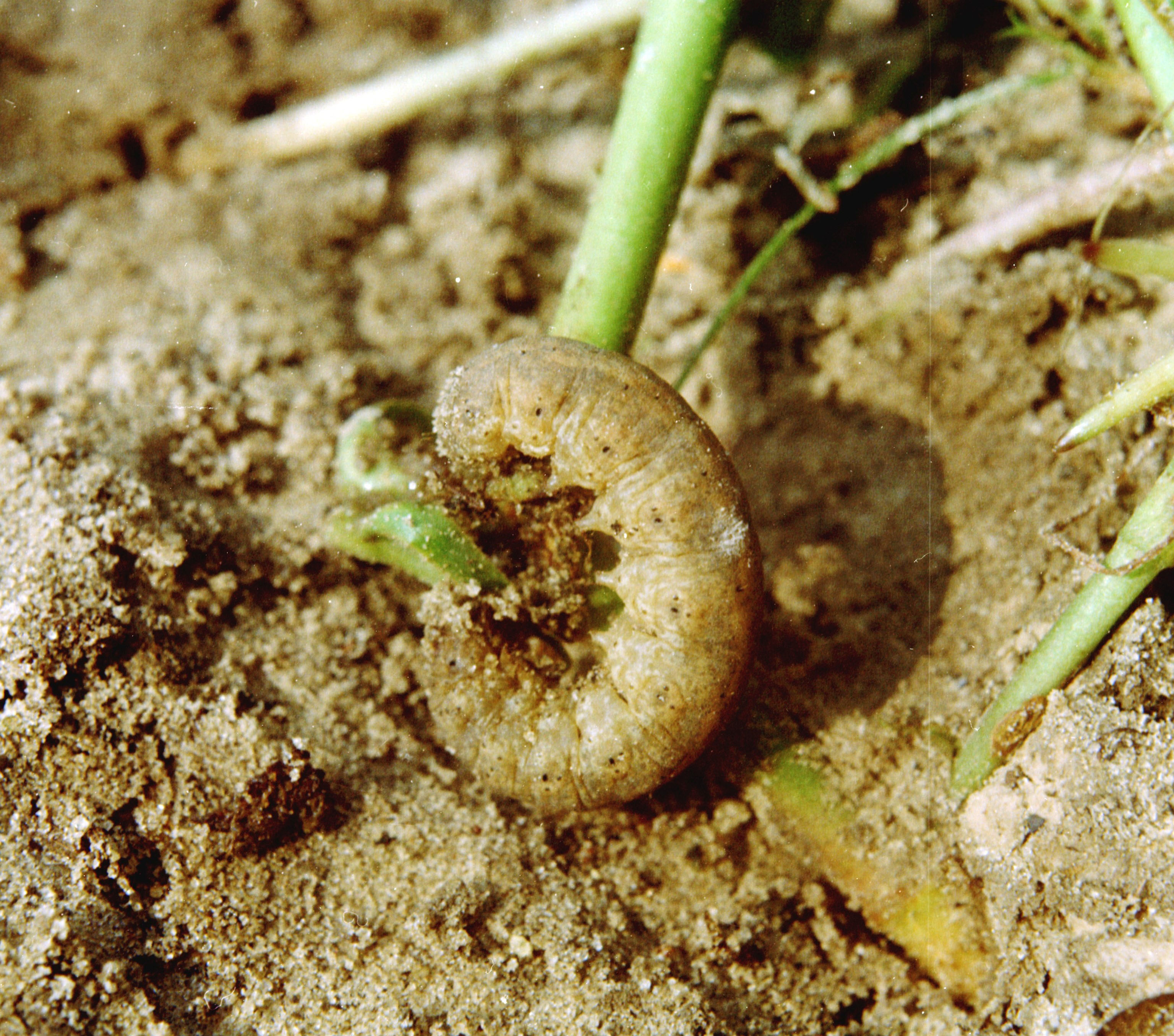
Aphids
Aphids are tiny, soft-bodied insects that cluster together and feed on plants in nurseries and home gardens in the summer (Figure 4). They use their piercing-sucking mouthparts to suck plant sap from plant stems or the underside of leaves. Aphids secrete a sticky substance called honeydew on plants that, when the deposits are thick enough, can lead to the growth of black sooty mold and attract ants.
Control:
- Spray the plants with an insecticidal soap or neem oil.
- Apply an insecticide labeled for ornamental plants.
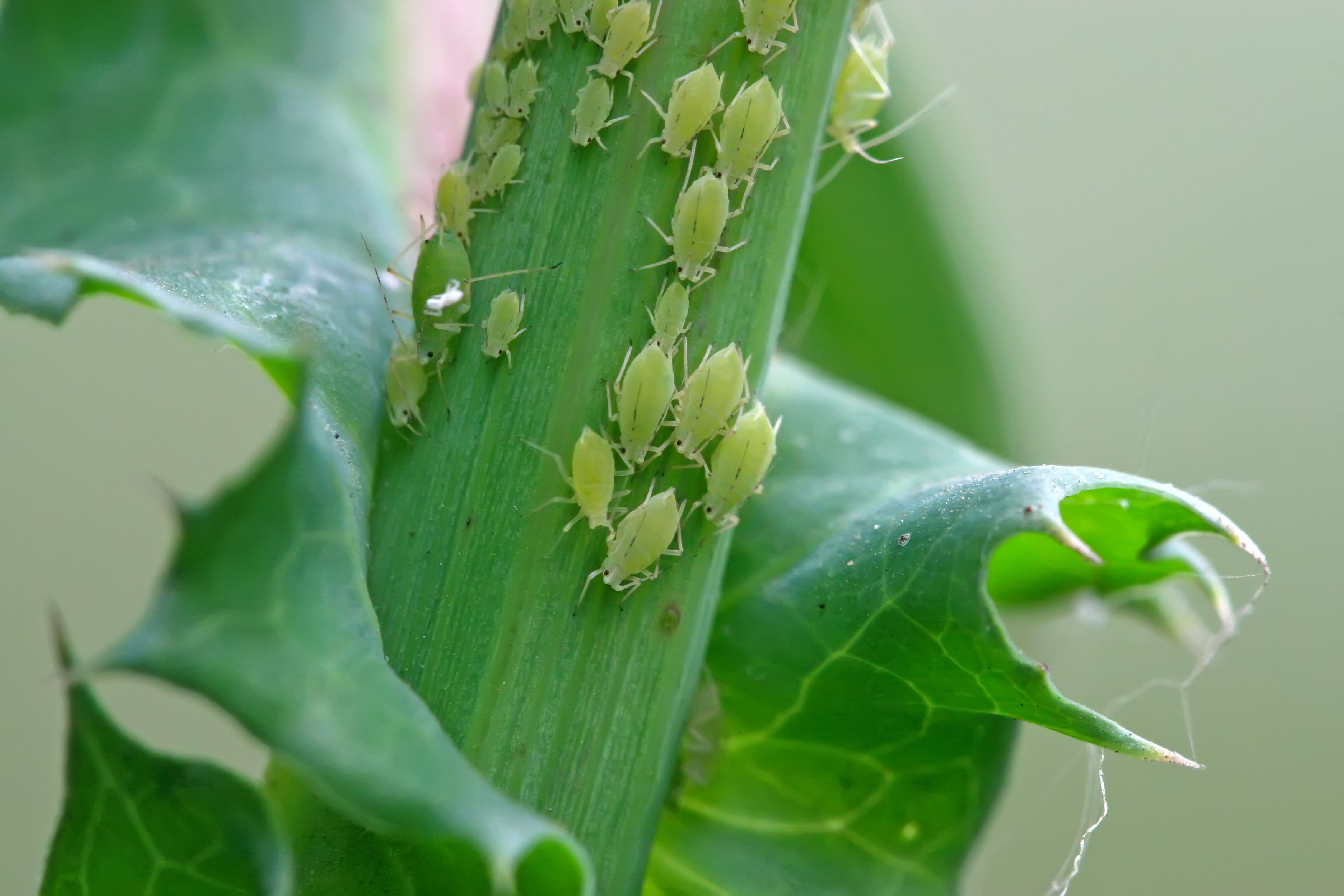
Grasshoppers
Grasshoppers (Figure 5) chew the outer margins of hosta leaves, leaving ragged edges or completely stripping the leaves off the stems.
Control:
Spray your hosta leaves with an insecticidal soap or neem oil.
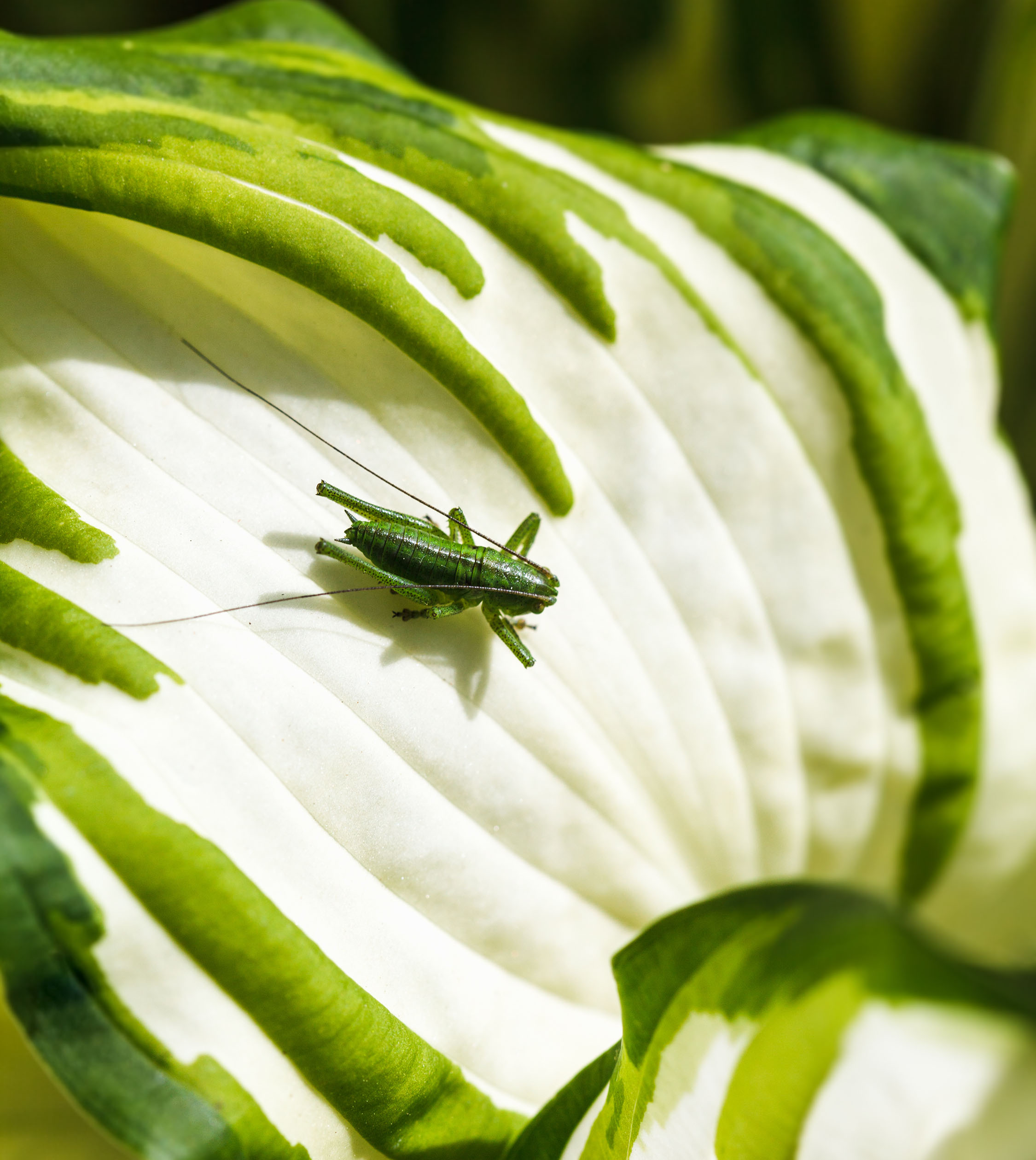
Plant-Parasitic Nematodes
Most nematodes that live in the soil are beneficial, but plant-parasitic nematodes feed on plants, damaging roots, stems, and leaves; stunting growth; decreasing vegetable and other crop yields; and sometimes even killing their hosts. Plant-parasitic nematodes are microscope roundworms that are known to infect almost every plant species worldwide. There are many species of plant-parasitic nematodes, the most common in Michigan are root-knot nematodes (Meloidogyne spp.), root lesion nematodes (Pratylenchus spp.), and cyst nematodes (Heterodera spp.). This section discusses two types of plant-parasitic nematodes that are problems for hostas: root-knot nematodes and foliar nematodes.
Root-Knot Nematodes
Root-knot nematodes (Figure 6) are the most economically devasting plant-parasitic nematodes in the world. In Michigan, we have the northern root-knot nematode, M. hapla. This parasite lives on a variety of ornamental plants, including hostas and daylilies. Root-knot nematodes are sedentary endoparasites, which means the females set up permanent feeding sites inside a plant root and don’t move for the rest of their lives. As a nematode grows, the plant root grows and swells around it, forming a gall or knot (Figure 7). Symptoms of root-knot infestation include galled, swollen, and stunted roots, and plants that wilt easily, have poor vigor, and have chlorosis (yellowing due to lack of chlorophyll) and other symptoms common to nutrient deficiencies.
MSU Plant and Pest Diagnostics can test soil samples for the presence of nematodes. (Note: The soil testing done for consumers by the MSU Soil and Plant Nutrient Lab for pH and nutrient levels does not include checking for nematodes.)
Control:
Unfortunately, once these nematodes are in your soil they are impossible to get rid of because they can live in the soil without a host for years. Therefore, use only clean planting material and clean your garden tools and shoes regularly to help prevent root-knot and other nematodes from spreading in your garden.
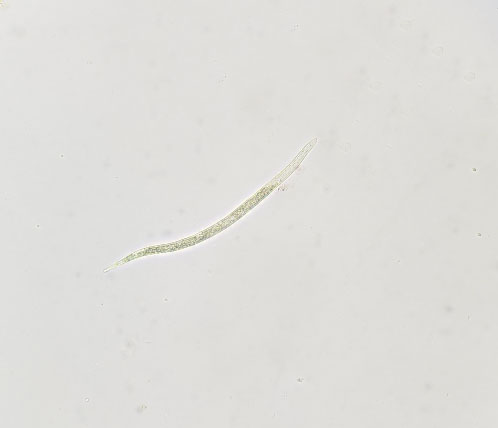
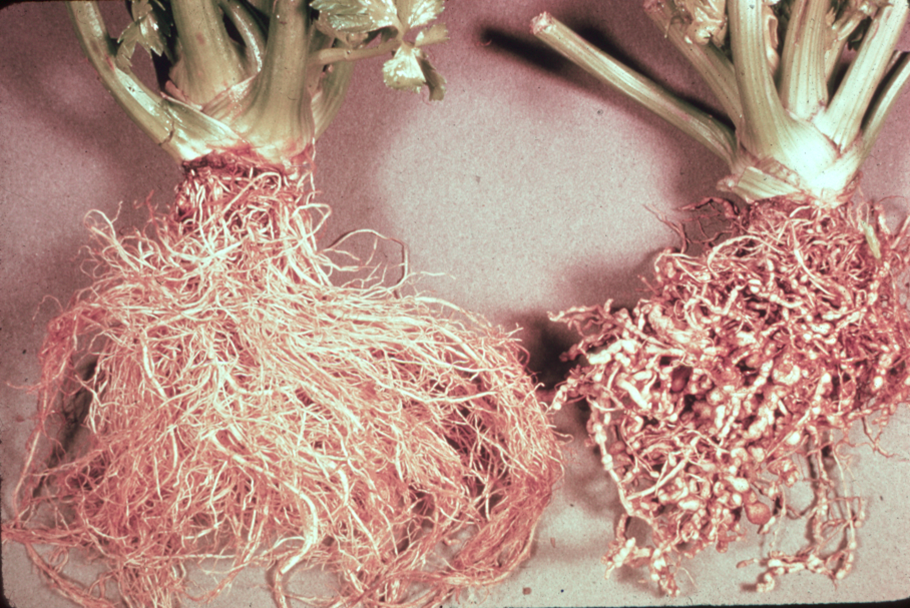
Foliar Nematodes
Foliar nematodes, Aphelenchoides spp., are another group of microscopic roundworms that live and feed on and within plant leaves. They can infest over 700 plant species, including many ornamental plants. Foliar nematodes are splashed from plant to plant by rainwater, overhead irrigation, and other water sources. Symptoms of their feeding are chlorotic linear lesions that run parallel to the leaf’s veins; eventually these lesions on the affected leaf tissue will die (Figure 8). This can give hosta leaves a dry, tattered appearance.
Control:
Remove, bag, and throw away all infected leaves. (Note: Do not compost infected leaves.)
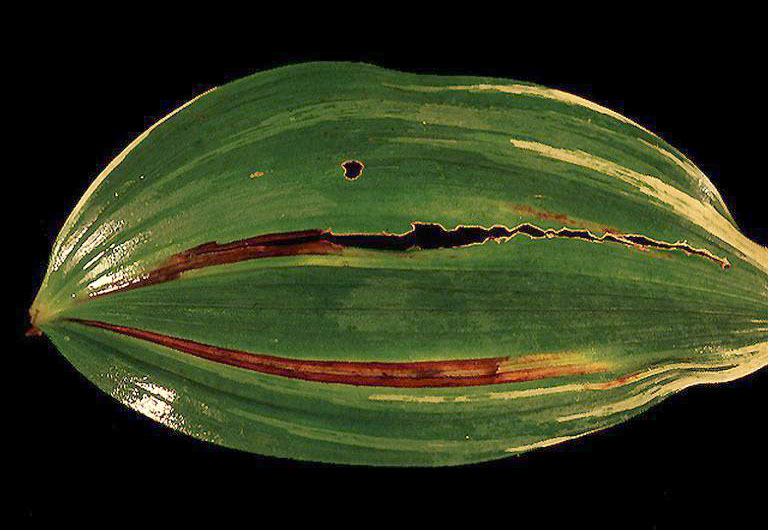
Pathogens and Diseases
Hostas are susceptible to a number of pathogens and diseases that also infect vegetables. This section covers several of the most troublesome.
Anthracnose
Anthracnose is a disease caused by the fungus Colletotrichum spp. Symptoms include tattered leaves and irregular leaf spots with brown borders and tan or white middles. Small black dots within the lesions’ borders are reproductive structures (Figure 9).
Control:
Use the following methods to prevent or manage anthracnose in your hostas:
- The fungus thrives in wet, humid weather, and is spread through rain or irrigation water splashing from infected leaves. So, plant hostas further apart (how far apart depends on the variety) to prevent splashing and increase air circulation around the plants. Monitor your plants carefully in wet, warm springs.
- Apply a fungicide labelled for ornamental plants before symptoms appear as a preventive measure. If you know anthracnose is a problem in your landscape beds, spray the fungicide when the hosta foliage starts to grow in the spring.
- Remove all infected leaves, seal them in a plastic trash bag, and throw away the bag. (Note: Do not compost diseased plant material.)
- Plant only disease-free plants.
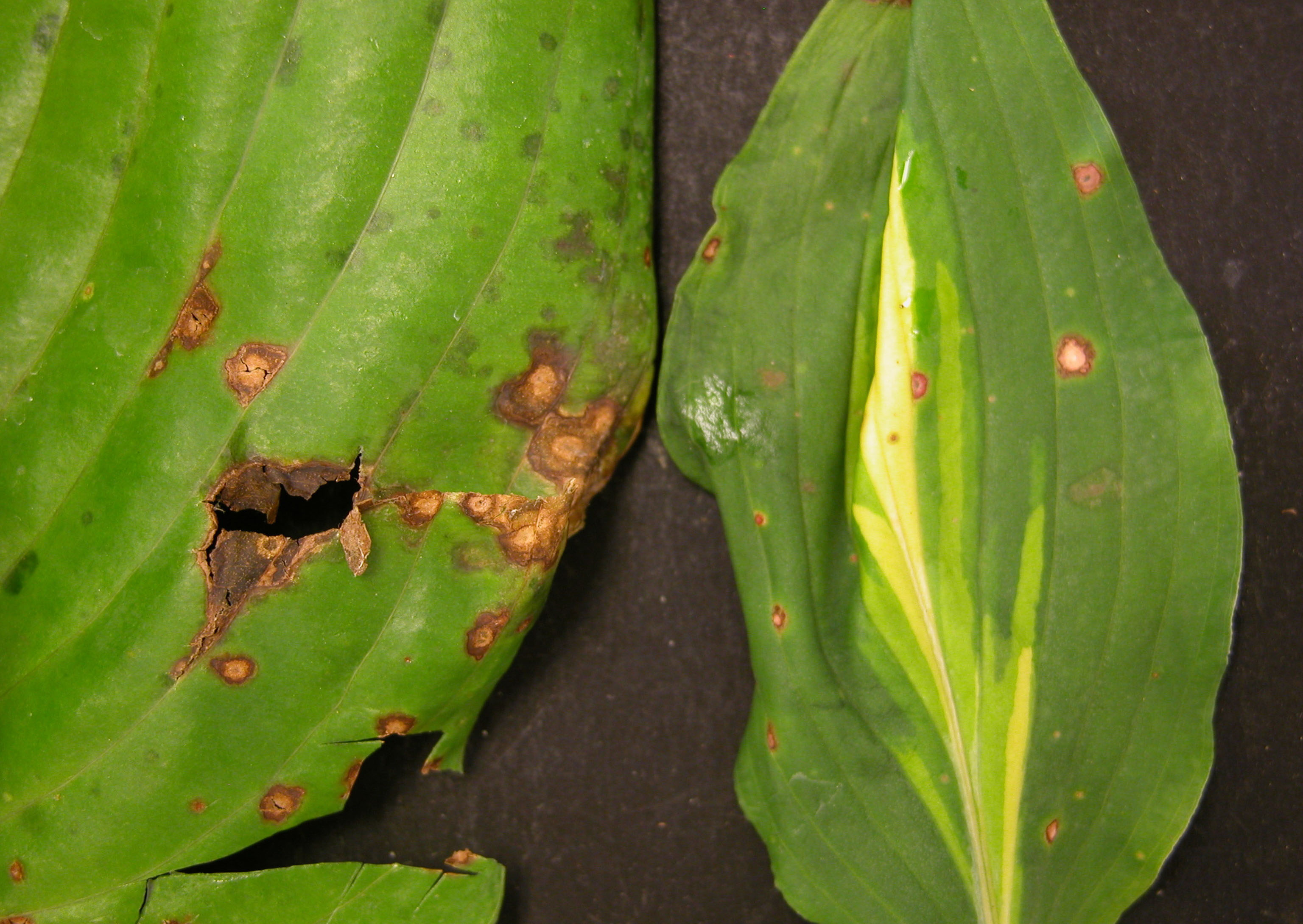
Fusarium Root and Crown Rot
Fusarium root and crown rot in hostas is caused by the fungus Fusarium hostae. It occurs mainly in container-grown plants but can also affect landscape plants. Symptoms usually start in late spring and include leaves turning yellow or brown, withering, and dying; stunted plants; and black-brown decay on the stems next to the soil.
Control:
- Pull any infected plants (including the roots) and several inches of soil around the infected plants. Seal everything inside a plastic trash bag and throw away the bag. (Note: Do not compost diseased plant material.)
- Follow good sanitation practices (such as regular cleaning and sanitation of garden tools, preventing wounding of the plant to prevent infection at the wound, and only buying disease-free plants).
Hosta Virus X
The main symptoms of hosta virus X (HVX) are yellow to green mosaic discoloration of the leaves, abnormally mottled leaves, and twisted leaves with brown spots (Figure 10). In extreme cases, the virus can kill the leaves, but it doesn’t usually kill the whole plant. HVX spreads quickly to nearby plants through infected plant sap.
Control:
Unfortunately, there is no cure for this virus, so the infected plant (including as much of the root system as possible) and the hostas surrounding it need to be pulled up, bagged, and thrown in the trash. (Note: Do not compost this material.)
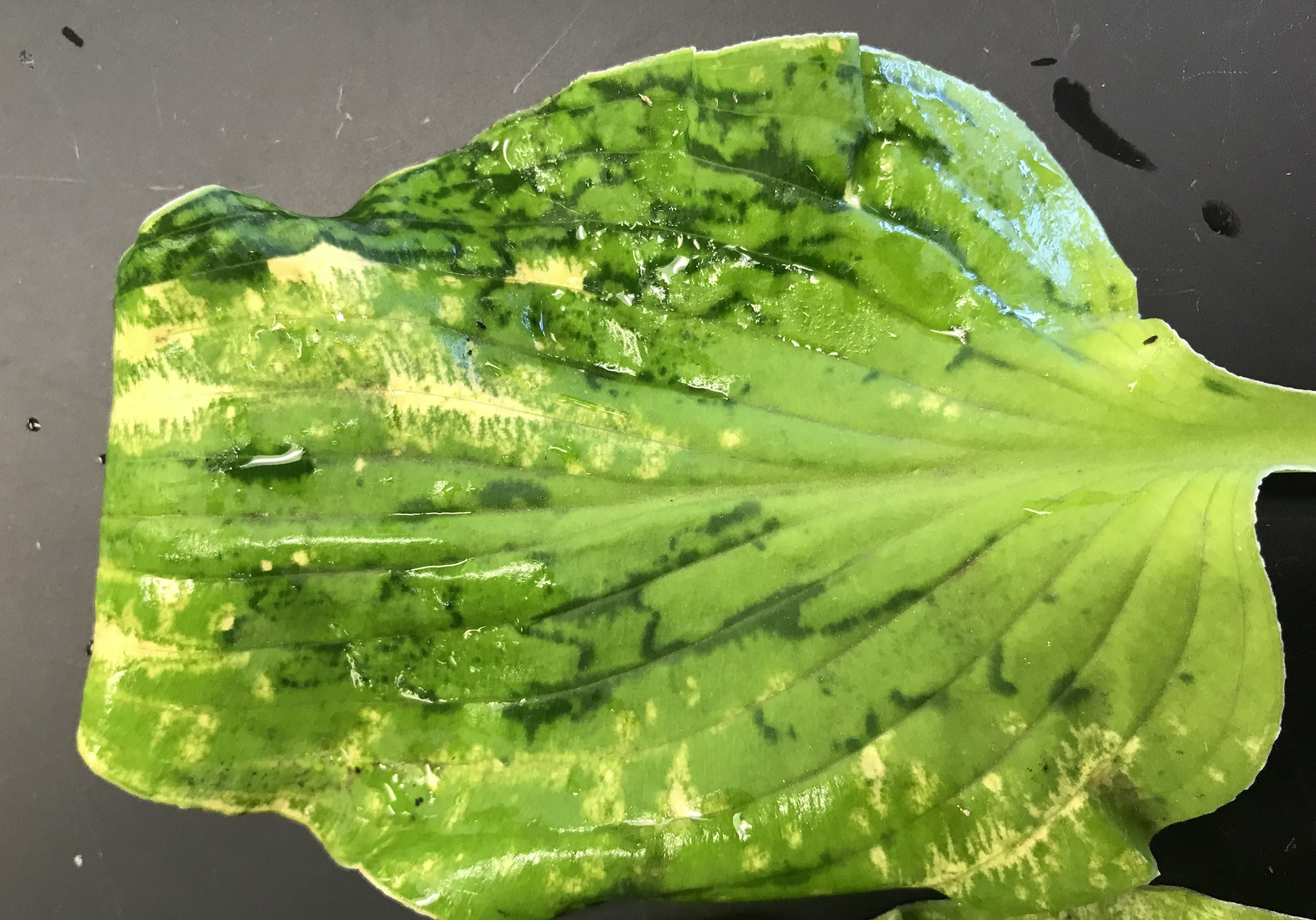
Southern Blight
Southern blight (also called petiole rot) is caused by the fungus Sclerotium rolfsii. The disease is more common in younger plants and during warm, humid summers. The first symptoms in infected plants are the lower leaves turning yellow and wilting. Later, infected leaves will turn brown. The upper leaves will also eventually wilt. Infected leaves can be pulled off easily and will eventually die (Figure 11). Soft, brown, mushy decay can also be seen at the base of the petioles (leaf stalks), sometimes accompanied by white fungal masses (Figure 12).
Control:
S. rolfsii is a soil-borne pathogen that can spread quickly, so it’s important to act as soon as your hostas show symptoms of southern blight:
- Pull up the infected plants and remove the soil and any wood mulch for 6 to 8 inches around the plants and replace it with clean soil. Bag and seal the material you removed and throw away the bag. (Note: Do not compost this material.)
- Sanitation methods such as inspecting incoming plants for signs of disease and cleaning gardening tools often and at the end of every work session will also help prevent its spread.
- Apply a fungicide labeled for ornamental plants to help prevent or treat southern blight.
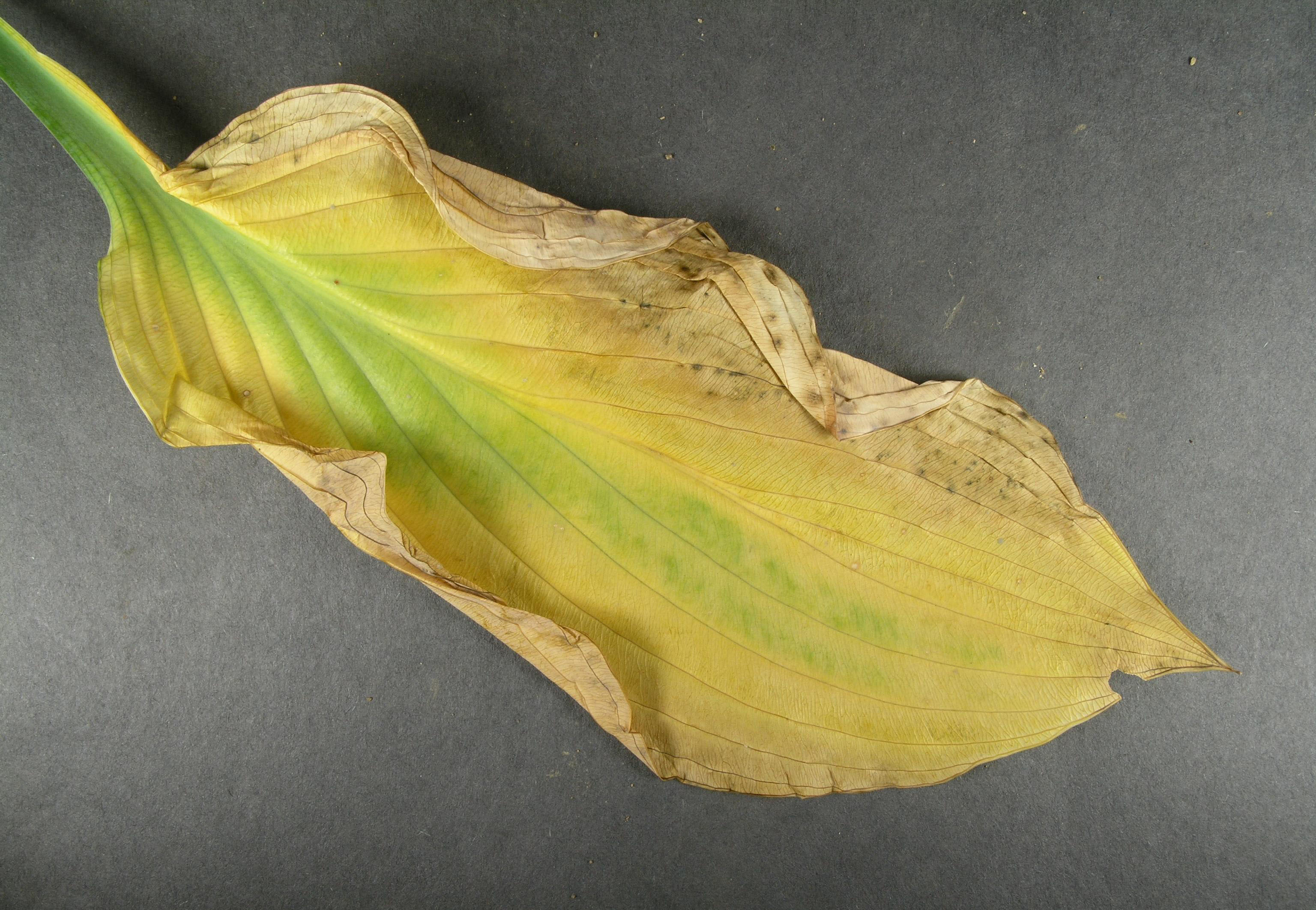
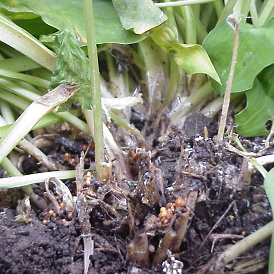
Find Out More
If you need help identifying a plant pest or disease, contact your local MSU Extension office or visit the MSU Soil and Plant Nutrient Laboratory website or the MSU Plant and Pest Diagnostics website.
The online resources listed here and in the “References” section can help you find out more about the pests and diseases described in this bulletin.
Michigan State University and MSU Extension Resources
- Gardening in Michigan —This MSU Extension website offers a variety of tips and resources on topics such as the Smart Gardening Initiative, the MSU Extension Master Gardener Program®, and the statewide gardening hotline.
- Nematodes in Home Gardens and Landscapes —This publication, from MSU Plant and Pest Diagnostics, discusses helpful and harmful nematodes in vegetable and ornamental gardens, small fruit plantings, trees, and lawns. It also discusses how to control plant-parasitic nematodes.
- Plant and Pest Diagnostics —This MSU laboratory offers plant health analyses and identification of nematodes, weeds, insects, and other arthropods on a fee-for-services basis.
Other Resources
- American Hosta Society —This national, not-for-profit organization promotes, encourages, and fosters the development of hostas.
- Diseases and Disorders —This landing page describes and links to fact sheets on plant diseases and disorders that have been developed by the University of Wisconsin-Madison Plant Disease Diagnostics Clinic and Division of Extension.
- Growing Hostas —This introduction to growing hostas offers information on hosta characteristics and propagation and the insects and diseases that trouble these plants. The bulletin was developed by Iowa State University Extension and Outreach.
- Hosta Problems —This landing page on the Missouri Botanical Garden website offers brief descriptions of wildlife, insect, environmental, and disease issues that can beset hostas, and links to fact sheets on each.
References
Cleveland, T. (2019, June 28). Hosta petiole blight. Home, Yard, and Garden Pest Newsletter (issue 6). University of Illinois Extension. https://bit.ly/3zHimhb
Hayes, R. F., Zlesak, D. C., & Moncada, K. (2018). Hostas. University of Minnesota Extension. https://extension.umn.edu/flowers/hostas
Joy, A., & Hudelson, B. (2021). UW plant disease facts: Southern blight (D0103). University of Wisconsin-Madison Extension, Plant Disease Diagnostics Clinic. https://pddc.wisc.edu/2019/01/06/southern-blight-2/
Missouri Botanical Garden. (n.d.). Hosta problems. https://bit.ly/3OHvh7a
Moorman, G. W. (2016). Hosta diseases. PennState Extension. https://extension.psu.edu/hosta-diseases
Mueller, D., Gleason, M., Lewis, D., Jeffers, S., Edmunds, B., Warfield, C., & Williams-Woodward, J. (2005). Hosta diseases and pests—Sustainable urban landscapes. Iowa State University Extension and Outreach. https://store.extension.iastate.edu/product/6625
Warner, F., & Tenney, A. (n.d.) Nematodes in home gardens and landscapes. Michigan State University Plant and Pest Diagnostics. https://bit.ly/3PKxdgr



 Print
Print Email
Email